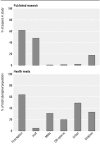Review of research on aboriginal populations in Canada: relevance to their health needs
- PMID: 12933728
- PMCID: PMC181255
- DOI: 10.1136/bmj.327.7412.419
Review of research on aboriginal populations in Canada: relevance to their health needs
Abstract
Objective: To determine if research has adequately examined the health needs of the aboriginal population of Canada.
Design: Review.
Study selection: Medline search of journal articles published during 1992-2001. The search terms used were "Canada" and various synonyms and categories for Canadian aboriginal people. Each paper was categorised according to the aboriginal group, age-sex group, comparison group, geographic location, and type of research topic (health determinant, health status, or health care).
Results: Of 352 citations found, 254 were selected after elimination of those without abstracts, not containing data on Canada, or not focusing on health issues. The proportion of papers does not reflect the demographic composition of aboriginal people in Canada, with severe under-representation of Métis, urban aboriginal people, and First Nations people not living on reserves and over-representation of the Inuit. Children and women received less attention proportional to their share of the population. A few prolific research groups have generated a disproportionate amount of publications from a few communities and regions. 174 papers dealt with health determinants (for example, genetics, diet, and contaminants), 173 with health status, and 75 with health care. Injuries, which account for a third of all deaths, were studied in only 8 papers. None of the health care papers examined rehabilitation.
Conclusion: Researchers have not adequately examined several important health needs of the aboriginal population.
Figures
References
-
- Waldram JB, Herring DA, Young TK. Aboriginal health in Canada: historical, cultural, and epidemiological perspectives. Toronto: University of Toronto Press, 1995.
-
- Commission on Health Research for Development. Health research: essential link to equity in development. New York: Oxford University Press, 1990.
-
- Global Forum for Health Research. The 10/90 report on health research 2001-2002. Geneva: 2002. www.globalforumhealth.org/pages/index.asp (accessed 22 July 2003)
-
- World Health Organization. The world health report 2002. Geneva: WHO, 2002.
-
- Statistics Canada. 2001 Census. Aboriginal peoples of Canada: a demographic profile. Ottawa: Statistics Canada, 2003. www12.statcan.ca/english/census01/products/analytic/companion/abor/conte... (accessed 22 July 2003)
Publication types
MeSH terms
LinkOut - more resources
Full Text Sources

